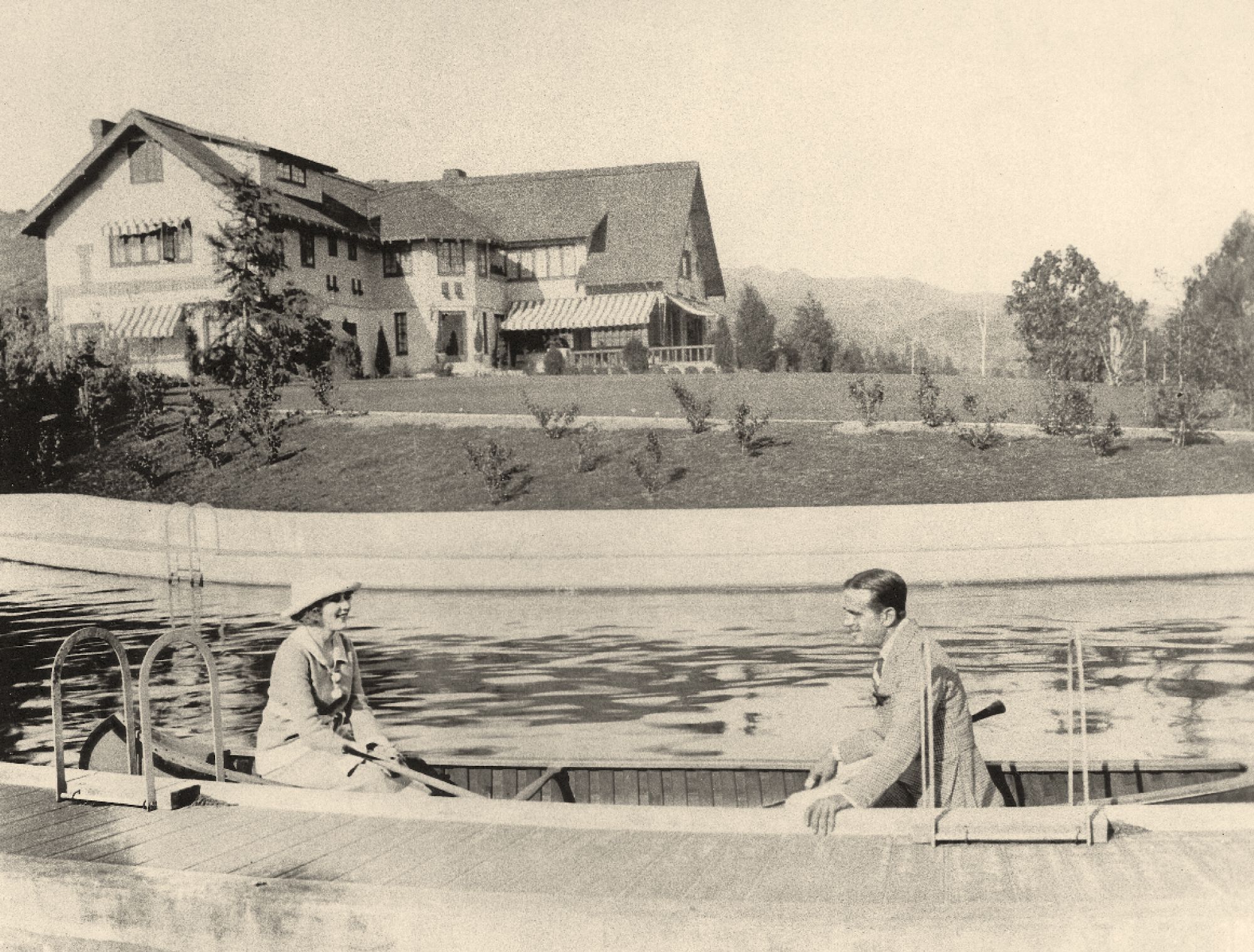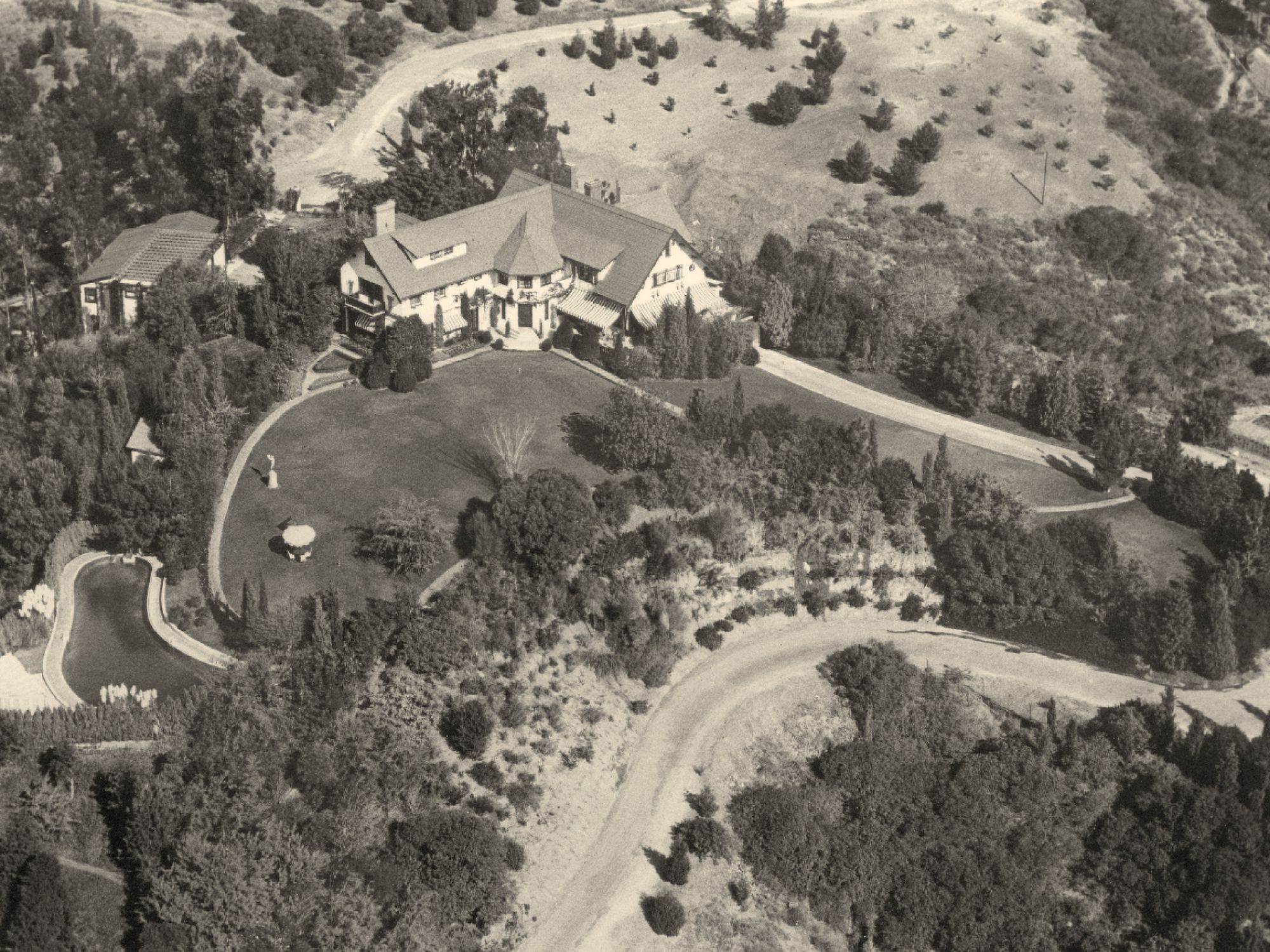Throughout the 1920s and 1930s, Douglas Fairbanks Sr. and Mary Pickford’s home, named Pickfair, was Beverly Hills’ best-known estate. Not comedian Harold Lloyd’s far more lavish Greenacres. Or the Doheny family’s even larger and more costly Greystone estate.
For many years, Pickfair was the most famous home in the United States, second only to the White House in Washington, D.C. The estate was even nicknamed the “Western White House.”
Fairbanks and Pickford were the King and Queen of Hollywood in the 1920s, and that aura enshrined their home for millions of fans.
Douglas Fairbanks Sr. (born Douglas Elton Thomas Ullman) was an actor, producer, director, and screenwriter. He had become a movie star during the late 1910s playing the wholesome “young man next door” in light comedies. He then achieved international stardom playing daring and athletic swashbucklers in action pictures including The Mark of Zorro (1920), Robin Hood (1922), The Thief of Bagdad (1924), and The Black Pirate (1926).

Fairbanks and Pickford in a canoe. Photo Credit: Randolph Harrison.
Although Canadian-born, Mary Pickford (born Gladys Louise Smith) became “America’s Sweetheart.” She started acting at the age of five to support her family and appeared in her first film in 1909 at age seventeen. She quickly became the fledgling movie industry’s first major star in the mid-1910s, earning the then-astonishing sum of $1,000 a week. Her films—including The Poor Little Rich Girl (1917), Rebecca of Sunnybrook Farm (1917), Daddy-Long-Legs (1919), Little Lord Fauntleroy (1925), and Sparrows (1926)—filled movie theaters across the nation. She soon was making $1 million a year.
While married to others, Fairbanks and Pickford began an affair in 1916 that was kept secret from their fans (some secrets were still possible in the early years of the film industry). Quick divorces led to their 1920 marriage, which sent their fans into paroxysms of delight. When Fairbanks and Pickford announced that they were going to live in Fairbanks’ Beverly Hills bachelor home, the national media—at the behest of the couple’s busy press agents—combined their last names and dubbed the estate “Pickfair.”
The actual house—for all the media fawning—was no larger than the homes of many well-to-do families in early-20th-century Los Angeles. Its architectural style was rather prosaic. The furniture—an eclectic mix of French neoclassical and Jacobean pieces—had come from Los Angeles department stores and created a comfortable country-gentleman style that Fairbanks wanted.
The fourteen-acre site, particularly a flat knoll overlooking Benedict Canyon and the distant Pacific Ocean, was the estate’s best feature.
Pickfair’s most memorable attribute—aside from its fame—was its almost continual transformations. Over many decades, the house was repeatedly redecorated or rebuilt into larger and more up-to-date residences that belied their relatively modest origins.
When Fairbanks purchased the fourteen-acre property on April 22, 1919, the house was a six-room hunting lodge built by life insurance company executive Lee A. Phillips in 1911. The sale price? $35,000.

Aerial photo of Pickfair. Photo Credit: Bison Archives.
With his typical zeal, Fairbanks began a $175,000 reconstruction of the lodge into what the Los Angeles Times described on July 6, 1919, as a “unique country place overlooking the sea.”
Fairbanks essentially gutted the interior, added two floors and a new wing, and turned the hunting lodge into a large, three-story, L-shaped house that was half English Tudor and half Swiss Chalet. It sat atop a small knoll surrounded by a newly planted landscape of lawns and trees, as well as ponds. Max Parker, the art director for many of Fairbanks’ films, served as the architect. The reconstructed five-bedroom house contained “numerous novel features incorporated in the plans at Mr. Fairbanks’ suggestion,” reported one article, including a first-floor “private projecting [sic] room to enable him to view his own and other pictures.”
Following their marriage, Fairbanks and Pickford regularly entertained long-time friends at Pickfair, including Chaplin, Lillian Gish, and screenwriter Frances Marion. At-home events were a necessity. The two stars could not venture beyond the movie studio or their estate without being besieged by fans. Pickford had almost been trampled to death by an adoring mob during their European honeymoon in 1920.
Long-time Hollywood friends weren’t the only ones who came to Pickfair. The wealthy, titled, and famous around the world were just as starstruck as millions of Americans . . . and just as eager to secure an invitation to Pickfair to bask in the glow of Hollywood’s royal couple. By the mid-1920s, Pickfair was host to a wide variety of celebrity guests, including Sir Arthur Conan Doyle, Amelia Earhart, Albert Einstein, F. Scott Fitzgerald, Henry Ford, Babe Ruth, George Bernard Shaw, and H. G. Wells.
Fairbanks and Pickford were routinely visited by the world’s remaining royalty for dinners or several-days-long visits, including King Alfonso XIII of Spain, Lord and Lady Mountbatten, the Duke of York, the King and Queen of Siam, the Crown Prince and Princess of Japan, and—most important of all—the Duke and Duchess of Windsor, for whom they constructed a detached guesthouse.
Chaplin, who lived next door, couldn’t resist kidding his good friend, Fairbanks, about the parade of titled guests at Pickfair.
“Hello, Doug. How’s the Duke?” Chaplin reportedly said to Fairbanks.
“What Duke?” asked Fairbanks.
“Oh . . . any Duke,” Chaplin replied.
“We’ve got several here right now,” quipped Fairbanks. “Which one do you want?”
In 1933, Pickford reluctantly retired at age forty after nearly three decades in films and more than two hundred movies. “I knew it was time,” she later said. “The little girl made me” . . . and killed her career in the end.
To burnish their fading roles as the King and Queen of Hollywood, Fairbanks and Pickford carried out a complete reconstruction of Pickfair in time for the Los Angeles Olympics of 1932.
Architect Wallace Neff rebuilt and enlarged the house into the then-fashionable Regency style, with an elegant white façade and red-tiled roof. Fashionable interior decorator Elsie de Wolfe used an 18th-century French motif throughout (Fairbanks insisted, somewhat incongruously, that a Wild West–style saloon be constructed on the ground floor). Landscape architect A. E. Hanson added formal gardens to the grounds. Finally, a pair of impressive wrought-iron gates—with the name “Pickfair” at the top of each stone gatepost—marked the entrance to the estate’s driveway.
In mid-1933, Pickford put Pickfair up for sale at $500,000. A lavish, twenty-four-page brochure proclaimed: “It would be difficult to find in all the world a home as celebrated as Pickfair.”
Nobody bought the estate.
In December 1933, Pickford filed for divorce when she learned of Fairbanks’ affair with ex–chorus girl Sylvia Ashley. After several failed reconciliations, the divorce became final in January 1936. Fairbanks married Sylvia Ashley that March (he died in December 1939 from a heart attack). Pickford married Buddy Rogers in June 1937.
Once again, Mary put Pickfair on the market. She and her new husband thought about building a home in Bel-Air. The new house, Buddy Rogers informed the New York American, would not be as “pretentious as Pickfair. Mercy no; only four master bedrooms, and of course tennis court, swimming pool, and things like that.”
Once again, no one wanted to buy Pickfair.
During the last fifteen years of her life, Pickford steadily sold off pieces of the property as Pickfair slowly deteriorated. The year before she died, the grounds (except for the lawns seen through the gate) were overgrown and marred with trash. The masonry wall along Summit Drive was buckling and crumbling. Inside the house were water-stained walls and floors cluttered with film memorabilia and even sports equipment.
In March 1980, Pickfair went on the market for $10 million. The original fourteen-acre estate shrunk to little more than two acres.
Again, Pickfair had no takers until the price was cut in half. In subsequent years, Pickfair was remodeled again and again, until virtually nothing inside remained from the Fairbanks and Pickford golden era. The property still carried the Pickfair name, but the history and magic were gone . . . but not forgotten.
